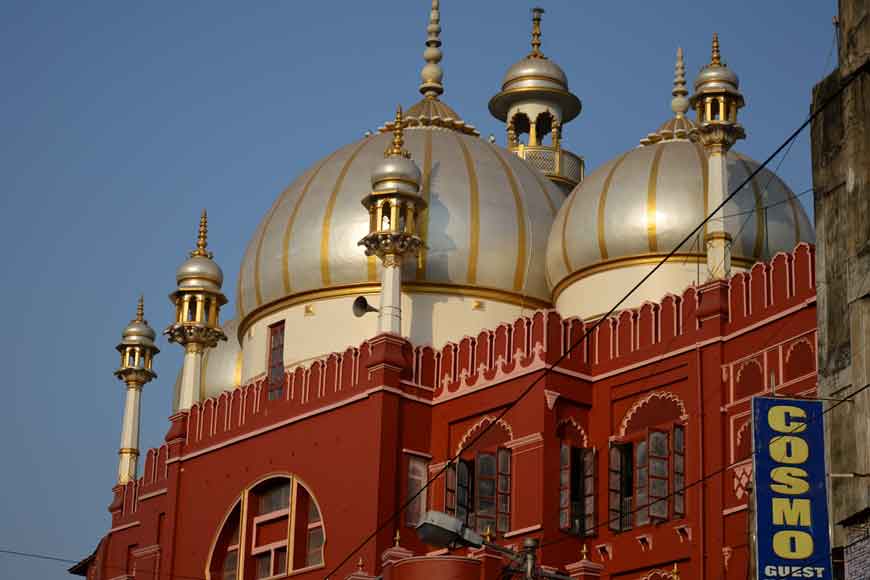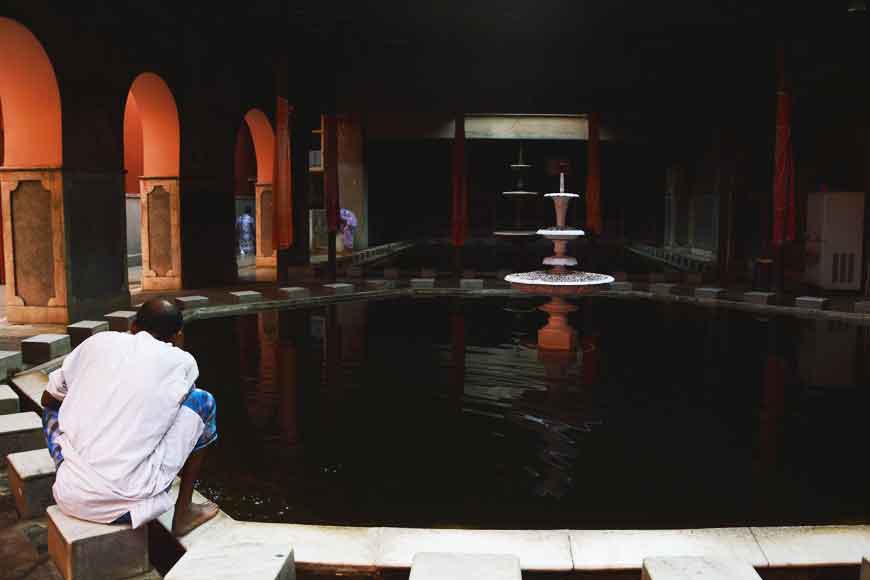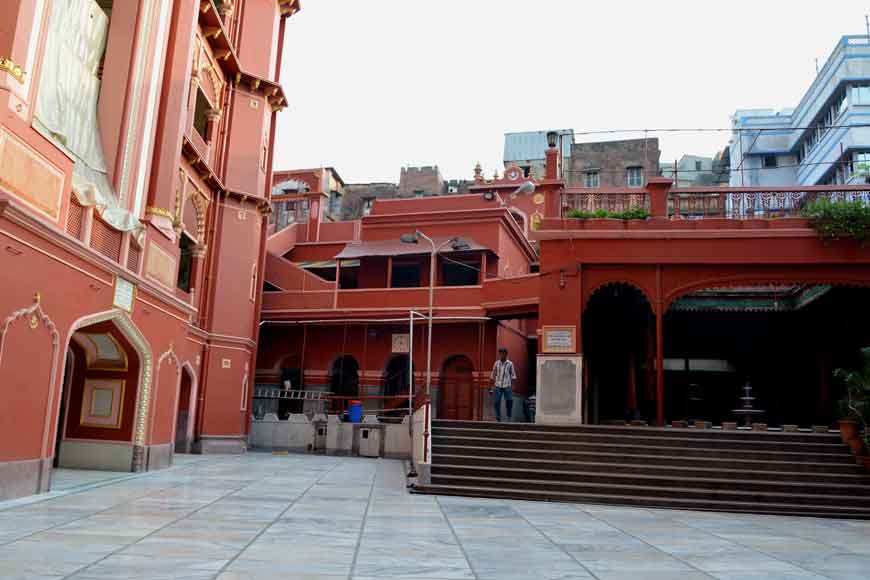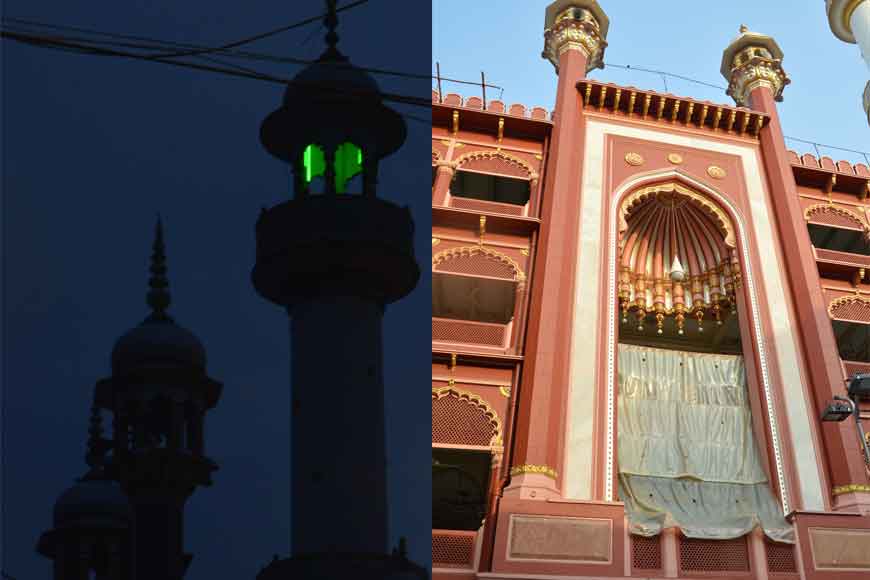The tales of Nakhoda Masjid

Arpita Chanda is a travel freak, foodie, and explorer of the past. Arpita is also a member of the group Purono Kolkatar Golpo
Nakhoda Masjid (1, Zakariya Street) near Lower Chitpur Road or present day’s Rabindra Sarani, is not only the biggest Mosque of West Bengal but also the biggest Mosque of Eastern India. It is also known as “Bari Masjid’. This architectural gem is a gift of a small religious community, known as Kutchi/Cutchi Memon Jama’at, a Mohammedan sect in Kolkata.
Now there is a question that ‘Who are the Cutchi Memon Jama’ at’?
A merchant community of Sind and Kathiawar region was known as ‘Lohana’ and was a part of Hindu Caste System. According to Hindu Varna system, they were ‘Vaishya’ or businessman community. But Lohanas used to consider themselves as Kshatriyas. Lohanas were divided into three separate cultural groups – Guajarati Lohanas, Sindhi Lohanas and Kutchi Lohanas. According to the book “Chachnama”, there was a Buddhist ruler of Brahmanabad in Sind called Agham Lohana. His estimated period of reign was around 636 AD and he was a member of Lohana clan and chief ruler of Lohana clan. He was the contemporary of Chach of Alor. The city Aghamkot(located in Hyderabad District, Sind, Pakistan) and the sea around the city, Lohana Darya or Lohana sea were named after him. In the battle of Brahmanad, Chach of Alor defeated and killed Agham Lohana and married his widow.

According to oral history of the Cutchi Lohana community, the decline of their kingdom began after the Death of Veer Dada Jashraj. It is also said that the name of the community was derived from the name of the city of Lohargadh or Lohkat in Multan. A leader called Mankeji who was the head of 84 Nukhs (groups) of Lohanas, was in favour in the court of Samma King. In the year 1432 (731 Hijri), 700 Lohana families comprising of 6,178 members was converted to Islam under his leadership by the great Muslim Saint Syed Ahmed Shahbuddin Jeelani Qadri in Thatta, Sind. As per history the saint called the newly converts as “Momins”, based on Arabic word ‘mu'min,’ means ‘believers (in Islam),’‘pious person.’ Al-Mu'min, 'the Believer' is one of the names of Allah (Qur'an 59:23). This term Momins later corrupted into “Memons”. Memons are a mercantile community. They consider themselves as from the Buddhist Kshatriya lineage.
The Lohanas of Thatta who converted themselves to Islam were invited by Rao Khengarji Jadeja, the ruler of Bhuj in 16th century, to settle down in Bhuj. So the Cutchi Memons, the largest of Memon Community, migrated to Kathiawar and to the mainland of Gujrat. The Memons became a successful and affluent businessman community by their trade in Surat from 1580 to 1680. As a mercantile community they settled mostly in coastal areas as they needed sailing for their trade. Cutchi Memons are Sunni Muslims. This community is well known for it’s Philanthropic works. According to the folklore, the secret behind the success of Memons in Business and trade is the blessing of Saint Syed Ahmed Shahbuddin Jeelani Qadri. But history says that the real story behind their success is that they are historically considered as honest Brokers.

The Cutchi Memons established their business in East and South –East Asian countries like Burma, Java, Singapore, Ceylon (Sri Lanka) and Mauritius from the early thirties of eighteen century. To maintain their business they came to Calcutta and settled here from 1849. Throughout the 18th century and early 19th century they were the supreme importers and exporters of general merchandise to and from these countries. In the rice and sugar trade they were considered as ‘king’. They carried the same business acumen and trading mentality as the Hindu Lohanas, their ‘source’ stock.
Cutchi Memons are also called “Nakhodas” or seafarers. There is an interesting story behind this name, a story of a Cutchi Memon Captain and his schooner (sailing ship). The ship full of Haji pilgrims, was going to Jeddah. A storm struck the sea and the passengers were alarmed. They begged the captain to save them. The Captain replied that he was a “Na-khuda” means ‘not God’ and asked them to pray to Allah for succour. From that time, Cutchi Memon Captains and ship merchants came to be known as ‘Nakhodas’.
The Cutchi Memon people did many great deeds in Calcutta during their heydays. They built Mosques, Madrassas, Musafirkhanas and cemeteries in Calcutta. They built the Nakhoda Masjid at a cost of Fifteen Lakh rupees in the year 1934. The foundation stone was laid on 11th September 1926 and the construction was ended on 1934. A small mosque existed there and the foundation stone of the new mosque was established on its place. Solemn and dignified in its construction, this sacred monument is modelled on Akbar’s Tomb at Sikandra, near Agra. The large prayer hall of this mosque has the capacity of accommodating 10,000 worshippers at a time. The mosque has three majestic domes and two lofty minarets of the height of 151 feet each. It also has 25 smaller minarets surmounted by cupolas; the heights of these minarets are of a range from 100 to 117 feet. The entrance is through the lofty arches of two imposing gateways of red sandstone from Dholpur. The design of the gateway is the replica of the famous Buland Darwaza of Fatehpur-Sikri. The four storey building of the mosque was built with white marble and red sand stone and it is an example of the Mughal Architecture.
Once the rich businessman Haji Noor Muhammad Zakariya after whose name the street in front of the mosque is named was appointed the ‘motoyali’ of this mosque. Now a committee manned wholly by the members of the Cutchi Memon Jama’at manages it. During the month of Ramzan the green light of the highest minaret indicates the proper timing of fast which is followed by all local Muslims.

Last but not the least, there is a joke that if there was no Cutchi Memon community then India might not get it’s Father of Nation. When a Durban (South Africa) based Memon firm, Dada Abdullah and Co., landed in disputes, they sought the services of a London educated, fellow Gujrati Lawyer, and Mohandas Karamchand Gandhi. In connection with a case of his employer Abdullah Karim Hajee Adam, travelled to Pretoria by a train and he was thrown out of a first-class carriage at Pietermaritzburg rail way station because of his colour. And the rest is history......











